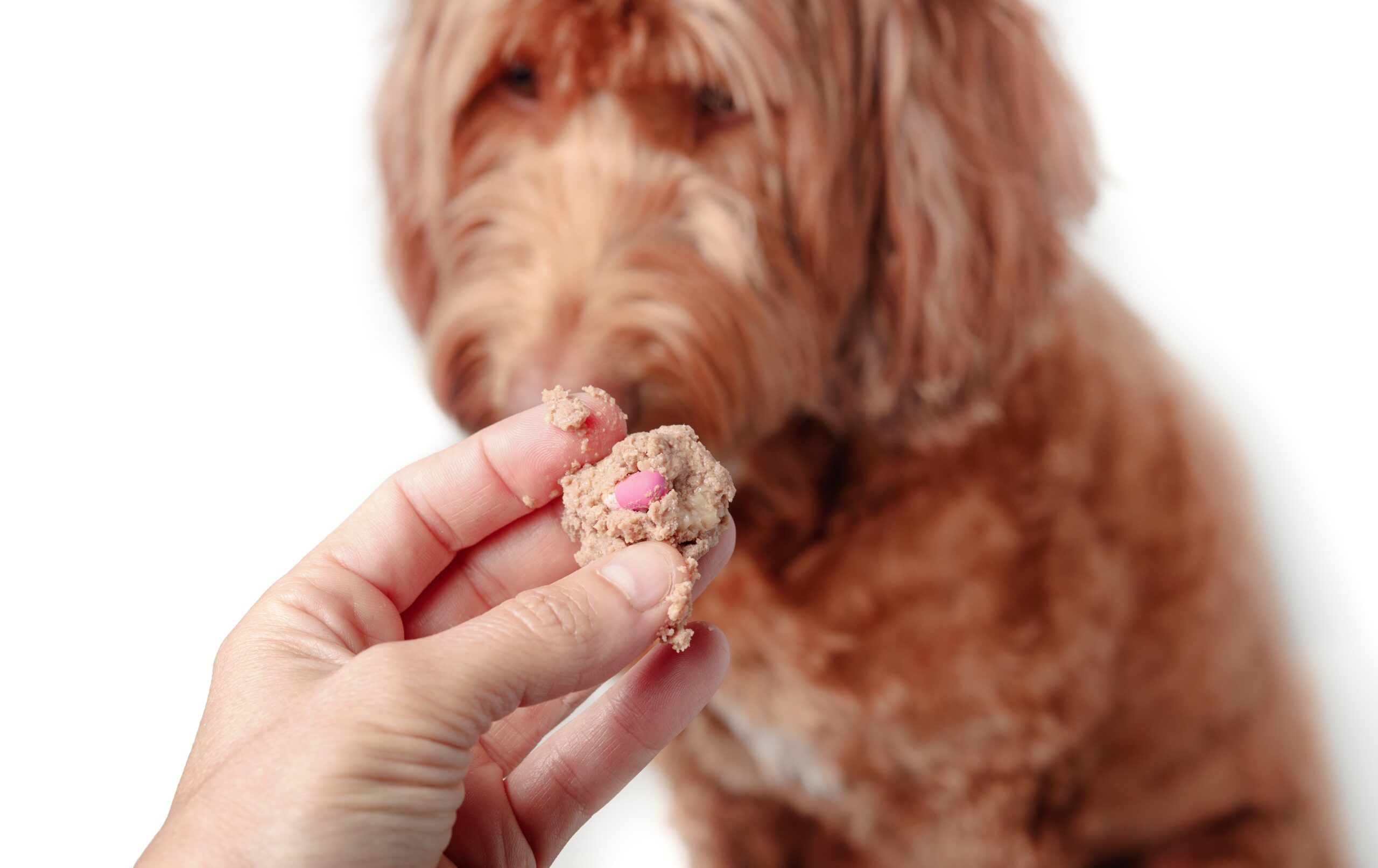It can sometimes seem like dogs will eat just about anything. Your shoe, that sock, a passport—scrumptious! But when it comes to the medicines that will help them feel their best, many dog parents are left frustrated when trying to get their pup to scarf down a necessary pill.
Picture it: You methodically hide your furry friend’s semi-annual heartworm pill in the tastiest, stinkiest wet food you can find. They’ll never know! But lo and behold, after your dog is done gobbling, you find the small round pill mocking you in the center of the bowl. Your pup saunters away, licking their chops smugly. Ugh.
It doesn’t have to be this way. Let’s look at some trusted methods for getting your resistant dog to take the medicine they need. And remember: After successfully giving your dog his meds, don’t forget to heap on the praise in order to reward the good behavior.
Tried-and-true methods
“The easiest way to give your dog his medicine, especially if your dog is food-motivated, is to hide it in a ‘high reward’ treat,” Megan McCarthy, DVM, veterinarian at the Lifesaving Center in Salt Lake City, Best Friends Animal Society, says. “This can be a small spoon of peanut butter, a small piece of lunch meat, a marshmallow, cheese-whiz or canned cheese, Kong squeeze treat, or a meatball of canned dog food.”
One caveat: If you’re using peanut butter, make sure it doesn’t contain an artificial sweetener like xylitol, since this is toxic for canines!
“Have your dog sit in front of you facing forward, away from you),” McCarthy explains. “Stand behind your dog so he cannot back up. Then, gently tilt his head upwards towards you, open his mouth wide, and place the pill as far back on the base of the tongue as you can. Close his mouth right away to encourage swallowing. You may put a small bit of water or peanut butter on your dog’s nose to encourage licking and swallowing.” (If you’d like a visual aid, there are some helpful YouTube videos that demonstrate this.)

Still won’t bite? Try pill pockets
A popular way to hide your dog’s medication is to use pill pockets; The Dodo recommends a number of options, including some from Greenies. They work best if your dog is the type to wolf down their treats. If your pup is more of a slow-chewer, they will likely notice any bitter taste of the pill, and spit the whole thing out. Ask your dog’s veterinarian or the pharmacy where you purchased the pills if they are bitter tasting.
Be sure to check the ingredients on the pill pockets container to see if any of the ingredients cause allergic reactions specific to your pup.
Capsules, compounded, or liquid medications tend to go down easier
Ask your dog’s veterinarian if the pill comes in capsule form, which would allow you to crack it open and mix the medicine into food. If the ingredients in the capsule have a bitter taste, mask it with peanut butter (again, avoid xylitol here), a small amount of cream cheese, or canned dog food.
Canned, wet dog food that comes as pate or gravy works well when mixed into meds. You can rub a bit of the mixture onto your dog’s mouth so he’ll lick it off.
Grinding or rolling up human food—like turkey, ham, or a small piece of cheese—and mixing in the medication is another way to get your dog to take his meds.
Compounded meds are not a one-size-fits-all medicine; instead, it’s made up of two or more medicines made specifically for your dog and it’s based on the prescription from your dog’s veterinarian. If your veterinarian recommends a compounded medication, you might have to purchase it at a compounding pharmacy. One compounded medicine can be easier for you and your dog to manage, as opposed to juggling a number of different pills.
Liquid medication is also a good option because it mixes easily into dog food. You can also give liquid meds via an oral “syringe.” Talk to your dog’s veterinarian about best practices here.
Try the paw
You can smash a pill, add powder medication, or mix liquid meds into a small amount of (xylitol-free) peanut butter, and smear it on your dog’s paws. They will lick it off and ingest the medication in the process.
Can’t fool that nose

If your dog turns up his nose to the meds mixed into his food it’s likely that it’s because of his sense of smell. Dogs are great at sniffing out all kinds of things that we believe are undetectable. They can smell 10,000 to 100,000 times more clearly than we can because they have more olfactory receptors in their noses than we do.
With that in mind, it’s a good idea to mask the smell of certain medications. Some have strong odors; others do not. Try mixing a tablespoon of tuna oil in with the food-and-medication mix to help mask the smell.
It sometimes takes two
Ask a friend or family member to help. Not all dogs are cooperative. Dispensing medicine is not only stressful for your dog, it can be stressful for you, too. Have someone hold your dog while you administer the medication. You can also ask your veterinarian for a demonstration.
Caring for your pup
We know you want the best care possible for your pup. That can mean the right pet health insurance policy, such as coverage offered by Lemonade. A base accident and illness policy will help cover diagnostics, procedures, and even medications if your pup has an unexpected accident or illness.
Plus, Lemonade also offers a number of preventative care packages, which can help cover the costs of routine care like wellness exams, vaccinations, tests, and more.
Apply today and learn more how Lemonade can help keep your pup happy and healthy for years to come!
A few quick words, because we <3 our lawyers: This post is general in nature, and any statement in it doesn’t alter the terms, conditions, exclusions, or limitations of policies issued by Lemonade, which differ according to your state of residence. You’re encouraged to discuss your specific circumstances with your own professional advisors. The purpose of this post is merely to provide you with info and insights you can use to make such discussions more productive! Naturally, all comments by, or references to, third parties represent their own views, and Lemonade assumes no responsibility for them. Coverage and discounts may not be available in all states.





